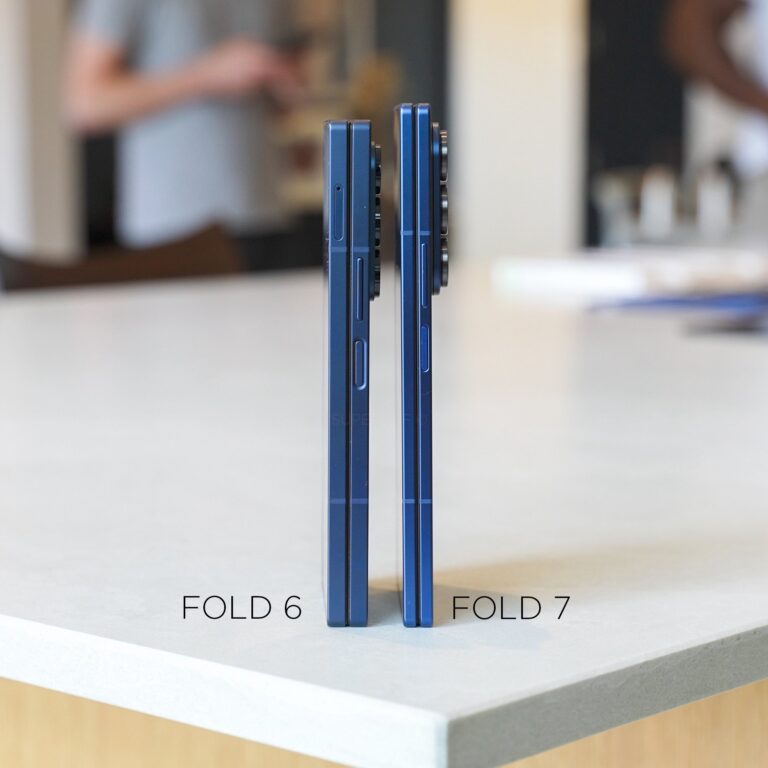
The Galaxy Z Fold 7 features a noticeably slimmer profile compared to the Fold 6, showcasing Samsung’s latest engineering advancements in foldable design.
Samsung’s latest foldable flagship represents a transformative moment in mobile technology evolution. The Galaxy Z Fold 7 emerges as a stunning testament to engineering prowess, delivering unprecedented thinness, premium materials, and cutting-edge performance that finally addresses long-standing criticisms of previous foldable generations. After extensive hands-on testing and market analysis, we can confidently say this device represents the closest any manufacturer has come to delivering a truly “mainstream-ready” book-style foldable smartphone.
The device commands attention not just for its $2,000 price tag, but for its ambitious attempt to redefine what consumers expect from premium foldable technology. This comprehensive analysis examines every aspect of Samsung’s newest flagship, from its revolutionary design achievements to real-world performance limitations.
Design Revolution: Ultra-Thin Engineering Marvel
Dimensional Breakthrough
The Samsung Galaxy Z Fold 7 achieves what seemed impossible just two years ago—a foldable phone that rivals traditional smartphones in portability. The device measures an remarkable 4.2mm when unfolded and 8.9mm when folded, making it the world’s second-thinnest book-style foldable. At just 215 grams, it weighs less than many flagship slab phones, including the iPhone 16 Pro Max and Galaxy S25 Ultra. For complete technical details, see the [full phone specifications]
“We’ve achieved another meaningful breakthrough in both durability and design. This new panel not only builds consumer confidence in foldable OLED durability but also underscores the technological advantage that makes Samsung Display distinguished in the industry.” – Hojung Lee, Samsung Display Executive Vice President
This dramatic size reduction stems from comprehensive re-engineering. Samsung replaced carbon fiber components with Grade 4 Titanium for the backplate, implemented high-density logic boards, and introduced a waterdrop-shaped hinge mechanism that reduces crease visibility while enabling the gentler folding angle.
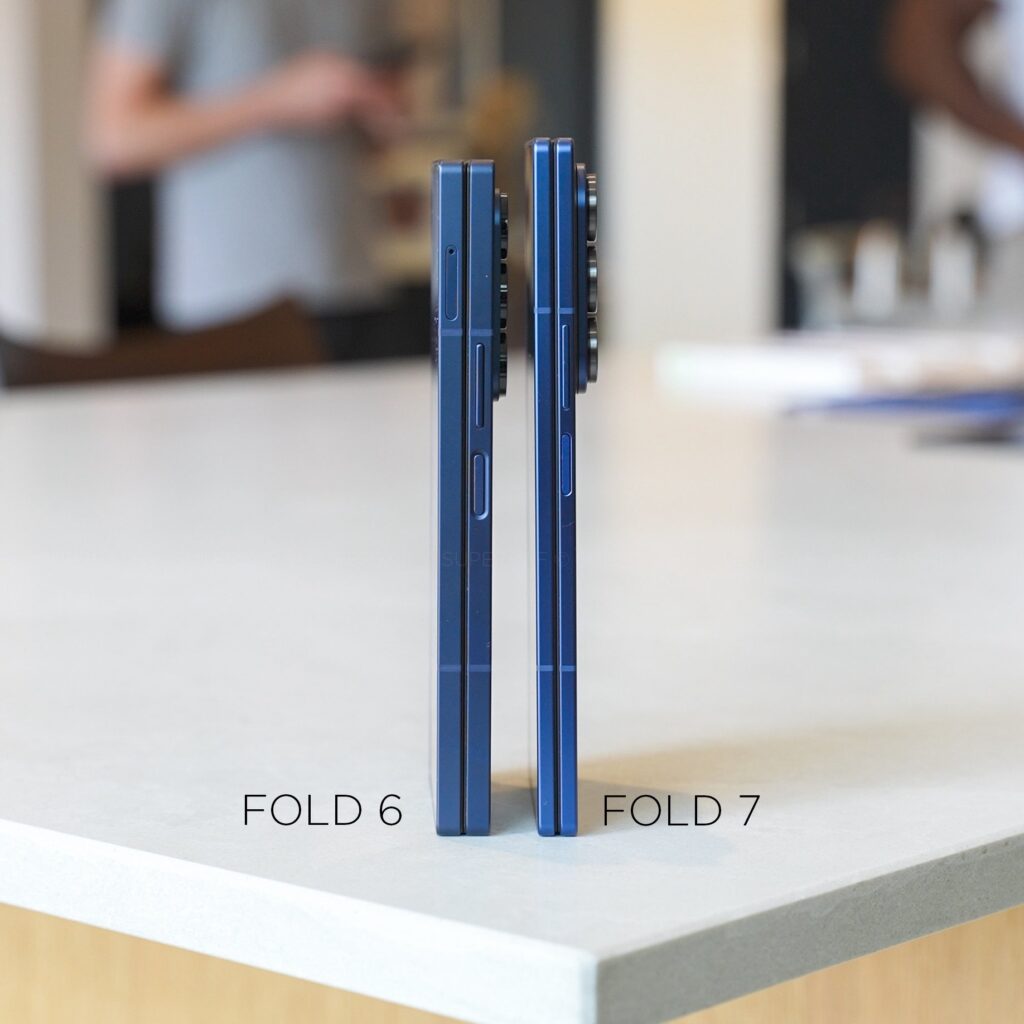
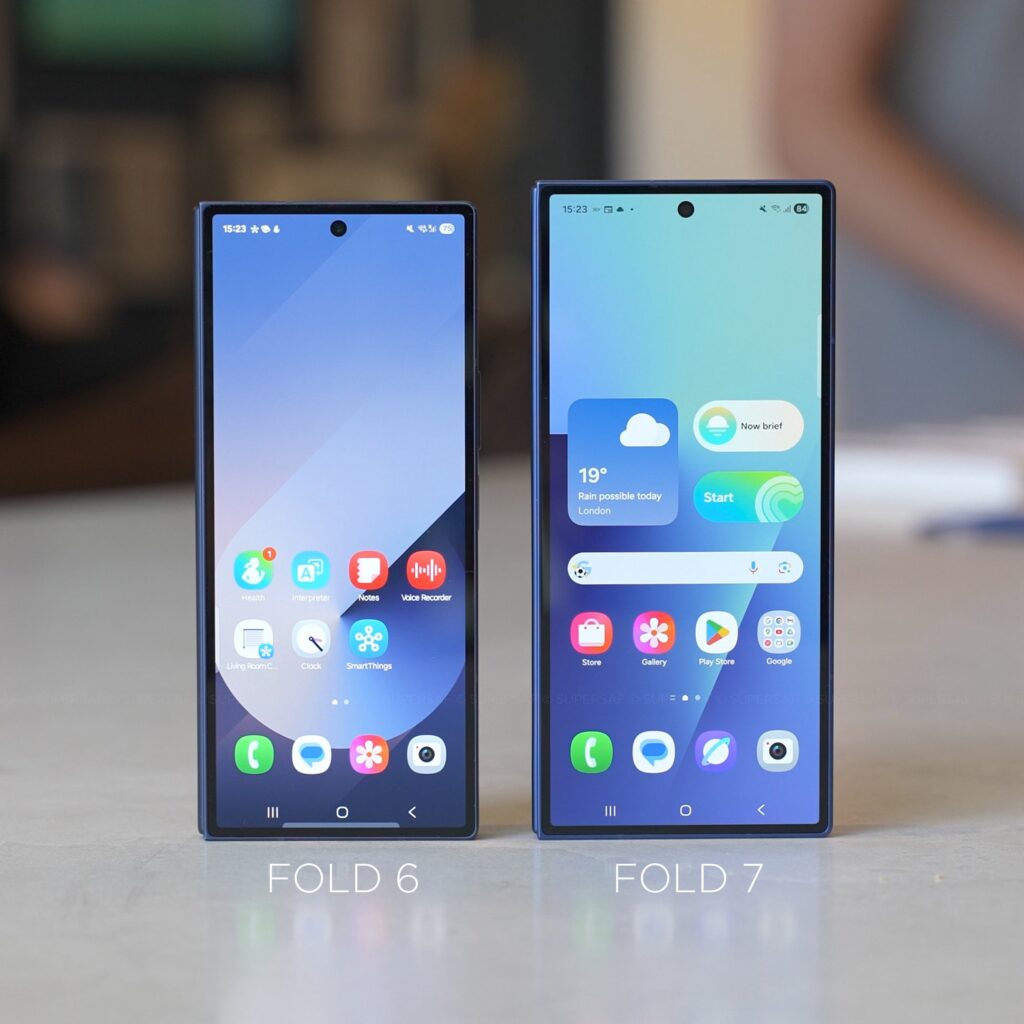
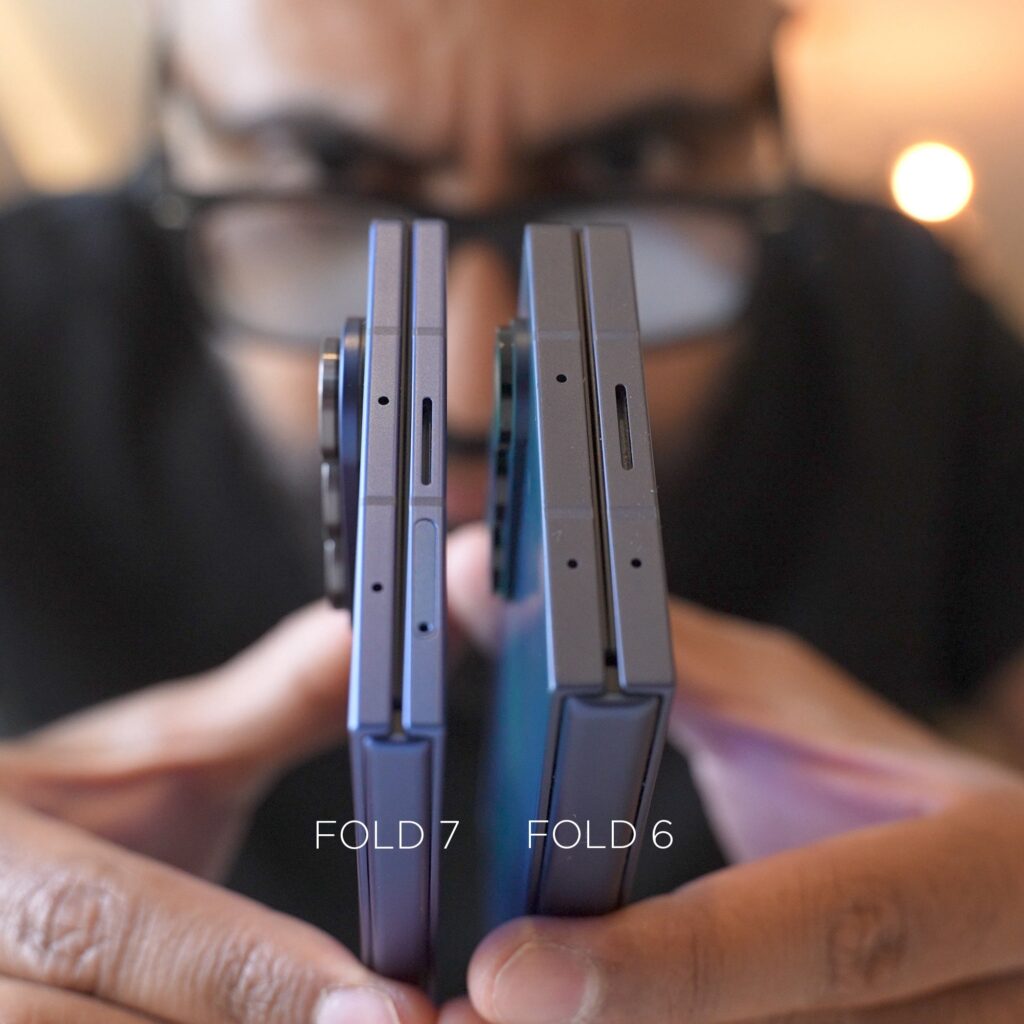
Material Innovation and Durability
Samsung’s durability improvements represent perhaps the most significant advancement in foldable technology. The display can withstand up to 500,000 folds, a 2.5x improvement over the Galaxy Z Fold 6’s 200,000-fold rating. This achievement translates to over 10 years of daily usage for typical users, or six years for heavy users folding the device 200 times daily.
The durability enhancement comes from bulletproof glass-inspired design, featuring:
- 50% thicker Ultra Thin Glass (UTG) protective layer
- High-elastic adhesive applied to every panel layer
- Titanium support plate for structural integrity
- Advanced Armor Aluminum frame construction
Display Excellence: Expanded Screens with Reduced Compromises
Cover Screen Transformation
The 6.5-inch cover display represents a fundamental shift in usability. Its 21:9 aspect ratio eliminates the narrow, awkward proportions that plagued previous generations. Users can now type comfortably, navigate apps intuitively, and use the device single-handed without feeling constrained by cramped screen real estate.
The transformation is immediately apparent in daily use. Basic tasks like texting, email, and social media browsing feel natural rather than compromised. This improvement alone addresses one of the most common complaints about earlier Z Fold models.
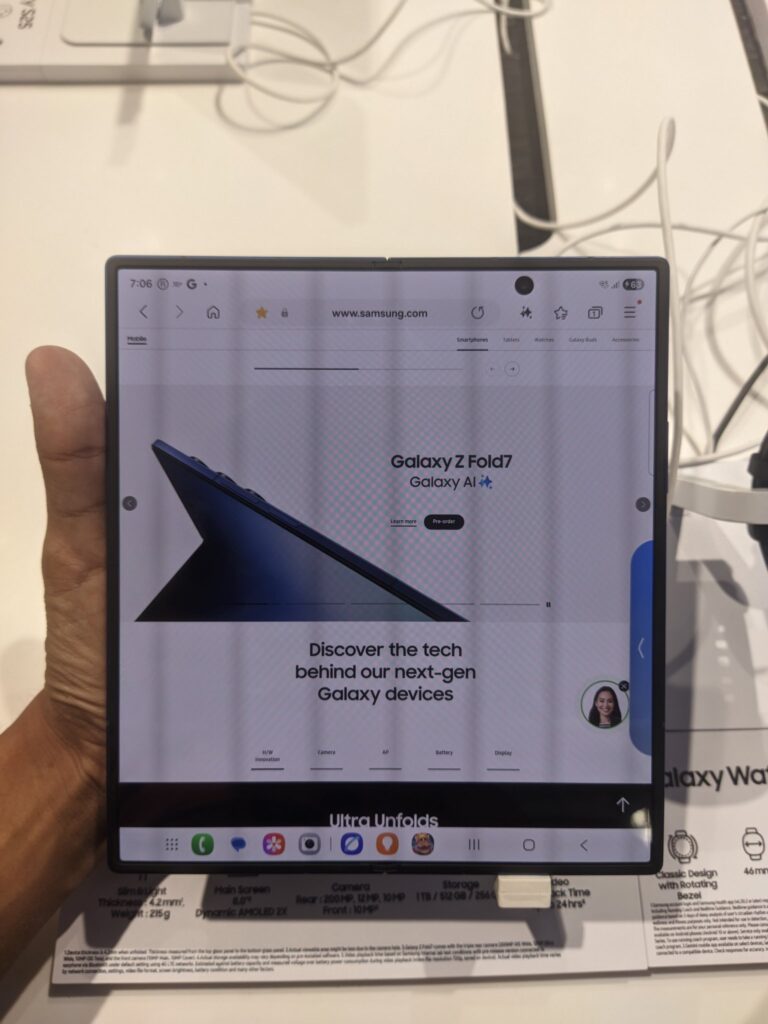
Inner Display Advancements
The 8.0-inch main display provides the most expansive screen real estate ever offered on a Galaxy smartphone. The 1968 x 2184 resolution delivers 368 ppi density with 2,600 nits peak brightness, ensuring excellent visibility even in direct sunlight.
Samsung’s crease reduction technology delivers noticeable improvements. The waterdrop hinge design creates a gentler folding angle, making the display crease less prominent during daily use. While not completely eliminated, the crease becomes far less distracting than previous generations.
Performance Powerhouse: Snapdragon 8 Elite Integration
Chipset Excellence
The Qualcomm Snapdragon 8 Elite chip for Galaxy represents a significant performance leap. This 3nm processor features custom Oryon CPU cores reaching 4.32GHz peak speeds, delivering up to 45% CPU performance improvement over the Snapdragon 8 Gen 3.
Benchmark results demonstrate impressive capabilities:
- Geekbench 6: 3,033 single-core, 9,271 multi-core
- AnTuTu: 2.75 million points
- 3DMark Wild Life Extreme: 6,311 points with 83.3% stability
Gaming and AI Performance
The Adreno 830 GPU delivers 40% improved performance with 40% better power efficiency compared to previous generations. Gaming enthusiasts can expect up to 2.5 hours extended gameplay thanks to these efficiency gains.
For AI applications, the Hexagon NPU provides 45% performance improvement over predecessors, processing up to 70 tokens per second on large language models. This enhancement enables seamless on-device AI processing for features like real-time translation and advanced photography enhancements.
Camera System: 200MP Photography Breakthrough
Main Camera Innovation
Samsung finally addresses camera complaints by integrating the same 200MP sensor found in the Galaxy S25 Ultra. This represents a massive upgrade from the Z Fold 6’s 50MP sensor, delivering significantly improved detail, dynamic range, and low-light performance.
The large sensor enables default 2x and 3x zoom shots through sensor cropping, providing optical-quality results without digital degradation. This capability partially compensates for the modest telephoto lens specifications.
Camera System Comparison
Photography Performance
Real-world testing reveals excellent results across most scenarios. The 200MP sensor captures exceptional detail with strong dynamic range and accurate color reproduction. Samsung’s computational photography excels in portrait mode, delivering uncanny edge detection that isolates subjects down to individual eyelashes[original source].
However, limitations remain. The 10MP telephoto lens struggles in low light and produces watercolor-like results beyond 5x digital zoom[original source]. Color inconsistency between sensors occasionally appears in video footage, though photo quality remains largely unaffected.
Battery Life Reality: Adequate but Not Exceptional
Performance Metrics
Despite retaining the same 4,400mAh battery capacity as its predecessor, the Galaxy Z Fold 7 delivers modest improvements in real-world usage. Testing reveals:
- Mixed usage: Approximately 5 hours 30 minutes screen-on time
- Battery test comparison: 10 hours 55 minutes web browsing (vs. Z Fold 6’s 10:35)
- Gaming performance: Slight decrease due to Snapdragon 8 Elite’s demanding GPU
Charging Limitations
Samsung maintains conservative charging speeds with 25W wired charging and 15W wireless charging. These specifications lag significantly behind Chinese competitors offering 66W-100W charging speeds. The charging limitation becomes particularly noticeable given the premium price point.
Battery optimization through Galaxy AI and the Snapdragon 8 Elite’s efficiency improvements provide marginal gains, but fundamental capacity constraints remain. Heavy users incorporating significant inner screen time will likely require daily charging.
Market Position and Competitive Landscape
Pricing Strategy
The Galaxy Z Fold 7 launches at $1,999 for the 256GB model, representing a $100 price increase over the Z Fold 6. Configuration pricing includes:
This pricing strategy positions Samsung as a premium option in an increasingly competitive market. Chinese manufacturers like Oppo, Honor, and Vivo are delivering comparable or superior specifications at lower price points.
Global Competition Intensifies
The foldable market faces unprecedented competition in 2025. All top five Chinese smartphone manufacturers are launching new foldable devices, including the ultra-thin Oppo Find N5, Honor Magic V4, and Vivo X Fold 4. These devices often feature:
- Superior battery capacities (5,600mAh+ vs. Samsung’s 4,400mAh)
- Faster charging speeds (80W-100W vs. Samsung’s 25W)
- Enhanced durability ratings (IPX9 vs. Samsung’s IP48)
- Competitive pricing with better value propositions
Market Growth Trajectory
The foldable smartphone market demonstrates robust expansion potential. Industry projections indicate:
- Market value growth: From $25.1 billion (2024) to $66.26 billion (2029)
- China market leadership: 9.2 million units sold in 2024, +31% growth
- Global shipments: Projected 27.6 million units by 2025
However, foldables remain niche, representing only 1.8% of total smartphone shipments expected in 2025.
Software Experience: One UI 8 and Android 16
Enhanced Multitasking
The Galaxy Z Fold 7 ships with Android 16 and One UI 8, providing enhanced multitasking capabilities designed specifically for foldable displays. The larger 8-inch screen enables legitimate productivity workflows, from split-screen apps to desktop-class web browsing.
Galaxy AI integration provides contextual assistance across applications, leveraging the Snapdragon 8 Elite’s processing power for on-device intelligence. Features include real-time translation, enhanced photography processing, and productivity automation.
Update Commitment
Samsung promises 7 major Android upgrades and extended security update support, ensuring long-term software viability. This commitment provides confidence for users investing in the premium device category.
Real-World Usage: The “So Nice” Factor
Daily Experience Benefits
Extended testing reveals the Galaxy Z Fold 7’s appeal lies in subtle convenience improvements. The outer screen finally feels “normal” for basic tasks, while the inner display provides genuine utility for:
- Web browsing with desktop-style tabs
- Gaming on a properly sized screen
- Multitasking with simultaneous app usage
- Media consumption with immersive viewing[original source]
The transformative aspect involves the seamless transition between compact portability and expanded functionality without the bulk penalties of previous generations.
Practical Limitations
Several compromises persist despite improvements:
- Camera bump wobble when placed on flat surfaces[original source]
- Stylus support removal affecting productivity workflows
- Premium pricing limiting mass market adoption
- Dust ingress concerns despite IP48 dust- and water-resistance
- Battery life constraints for power users
Future Implications: Foldable Technology Maturation
Industry Transformation
The Galaxy Z Fold 7 represents a pivotal moment in foldable evolution. Samsung finally delivers a device that addresses fundamental usability concerns while maintaining engineering excellence. This achievement forces competitors to match or exceed these standards, accelerating industry innovation.
The ultra-thin form factor proves foldable technology can deliver traditional smartphone convenience without significant compromise. This breakthrough likely influences consumer perception, potentially driving broader market adoption.
Innovation Trajectory
Samsung’s engineering achievements in durability, thinness, and performance establish new baselines for the foldable category. The 500,000-fold durability rating particularly addresses consumer concerns about long-term reliability.
However, challenges remain. Battery technology must evolve to support expanded displays without compromising portability. Charging speeds need improvement to match competitive offerings. Camera systems require further optimization for the unique foldable form factor.
Value Proposition Analysis
Target Demographics
The Galaxy Z Fold 7 appeals to specific user segments:
- Technology enthusiasts seeking cutting-edge innovation
- Business professionals requiring enhanced productivity tools
- Content creators benefiting from expanded screen real estate
- Early adopters willing to pay premiums for advanced features
Cost-Benefit Consideration
At $2,000, the device demands significant financial commitment. The value proposition depends heavily on individual priorities:
Justifiable for users who:
- Prioritize having the latest technology
- Require enhanced multitasking capabilities
- Value the unique foldable experience
- Can afford the premium without financial strain
Questionable for users who:
- Seek maximum value per dollar
- Prioritize battery life and charging speed
- Use basic smartphone functions primarily
- Prefer traditional smartphone ergonomics
Long-Term Durability Concerns
Real-World Longevity
While Samsung’s 500,000-fold rating impresses on paper, real-world durability extends beyond hinge mechanisms. The complex mechanical structure introduces multiple potential failure points compared to traditional smartphones.
Environmental factors remain challenging. The IP48 rating protects against particles larger than 1mm but doesn’t prevent all dust ingress. Users in harsh environments should exercise additional caution.
Maintenance and Repair
Samsung’s Class C repairability rating indicates repair complexity and potential costs. The intricate design likely results in expensive repairs for display damage, hinge issues, or internal component failures.
Extended warranty considerations become crucial given the premium investment and potential repair costs. Samsung’s care plans provide some protection but add to the total ownership cost.
Comparative Market Analysis
Direct Competitors
The Galaxy Z Fold 7 faces strong competition from established and emerging players:
Google Pixel 9 Pro Fold
- Price advantage: $1,799 vs. $1,999
- Similar performance: Comparable screen sizes and features
- Software integration: Native Android experience
- Limitations: Tensor G4 chipset less powerful than Snapdragon 8 Elite
Chinese Alternatives
- Oppo Find N5: Ultra-thin design, superior battery, IPX9 rating
- Honor Magic V4: Competitive specifications, aggressive pricing
- Vivo X Fold 4: Lightweight design, enhanced camera systems
Competitive Advantages
Samsung maintains several key advantages:
- Global availability and carrier support
- Established ecosystem integration
- Long-term software support commitment
- Build quality and premium materials
- Brand recognition and trust
Future Technology Roadmap
Next-Generation Expectations
Samsung’s foldable roadmap suggests continued innovation:
- Tri-fold devices potentially launching in Q3 2025
- Rollable displays under development for future products
- Enhanced AI integration across foldable experiences
- Improved battery technology addressing capacity limitations
Market Evolution
The foldable segment approaches a critical inflection point. As technology matures and prices stabilize, mainstream adoption becomes increasingly viable. The Galaxy Z Fold 7 represents significant progress toward this goal, though further improvements remain necessary.
Consumer education about foldable benefits and addressing durability concerns will prove crucial for broader market acceptance. Samsung’s engineering achievements provide a foundation for continued category growth.
Conclusion: The Refined Foldable Experience
The Samsung Galaxy Z Fold 7 successfully addresses many criticisms that plagued earlier foldable generations. Its ultra-thin design, enhanced durability, improved cameras, and refined software experience deliver a genuinely compelling product. The device finally feels like a “real phone” when closed while providing meaningful benefits when opened.
However, the $2,000 price point and remaining limitations prevent universal recommendation. Battery life, charging speeds, and some camera aspects still lag behind expectations for a flagship device. The value proposition depends heavily on individual priorities and financial circumstances.
For early adopters and productivity-focused users, the Galaxy Z Fold 7 represents the most refined foldable experience available. The engineering achievements and software optimization justify the premium for users who will fully utilize its capabilities.
For mainstream consumers, waiting for further refinements or more affordable alternatives might prove wiser. The device showcases impressive technology but hasn’t reached the balance of features, durability, and pricing needed for mass market appeal.
The Galaxy Z Fold 7 undoubtedly advances foldable technology significantly. Whether it achieves commercial success depends on Samsung’s ability to communicate its benefits while competitors continue pressuring prices and specifications. Regardless of market performance, this device establishes new standards that will influence the entire foldable category’s evolution.
Ready to experience the future of foldable technology? The Samsung Galaxy Z Fold 7 launches July 25th with pre-orders available now. Share your thoughts on foldable smartphones in the comments—are you ready to make the leap, or will you wait for the next generation? Subscribe to Future Tech Bites for continued coverage of emerging mobile technology trends.


